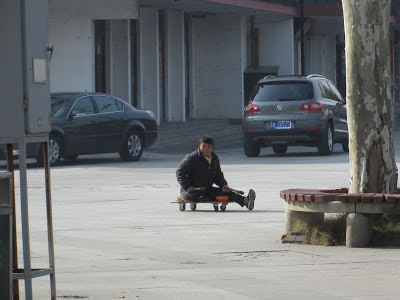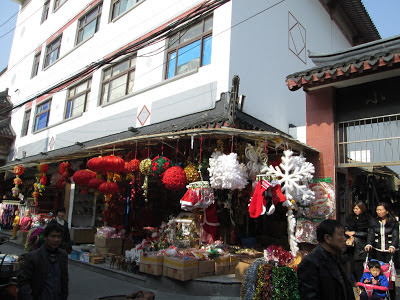There are lots of other great-looking statues showing various deities and spirits throughout the temple's many rooms and buildings.
The picture below was taken just outside the room where the Jade Buddha is, and - of course - you are not allowed to take pictures of the Buddha itself. Not that that's stopped me from taking photos before, but there were guards around. Plus, the Jade Buddha was really quite a disappointment after seeing the other portions of the temple, being surprisingly small and covered behind hard to photo glass.
The picture below is actually a copy of the Jade Buddha statue, though this one is actually bigger than the real version!
While the Jade Buddha statue is a legitimate temple, it is certainly geared towards the hordes of tourists that flock by, since it has western-style washrooms, loads of shops, and even sells Coca Cola!
 |
After touring the Jade Buddha Temple, I caught another cab and made my way over to Shanghai's largest temple, the Long Hua Pagoda (龙华寺).
The pagoda itself itself is over a thousand years old, but is closed to tourists. The remainder of the temple, however, is open to all. Like the Jade Buddha Temple, there are many interesting statues and carvings of other deities and many places for people to go and pray.
 |
| The red sheet of paper reads "Don't touch the Buddha's hand!" Obviously the temple has had some problems. |
After seeing the overwhelming number of touristy shops and coca cola dispensers at the Jade Buddha Temple, it was refreshing to see some actual monks that live and work at this temple.
I like that they put the lawn mower right next to the ancient stone tablet.
 |
| Classy |
Much like the Jade Buddha Temple, the Long Hua Pagoda had many vagrants just outside the entrance, most of which loudly screamed "Hello!" in English in their attempt to beg for change.
After I explored the Long Hua Temple, I got another cab and made my way to Shanghai's 'Old Town' (上海古城), the portion of the city where all of the Chinese used to live when Shanghai was divided into various foreign-controlled concessions.
Of course, the Old Town of today bears no resemblance to the to the squalid conditions that were there all those years ago, as it is now a highly touristy area filled with an unbelievable amount of shops, selling everything from tea sets, to Christmas merchandise, iPads, Tin Tin books, wigs, t-shirts, and every kind of toy imaginable.
 |
| All locally made too! |
My main reason for going to the Old Town was to see the Huxin Ting Tea House (湖心亭茶楼), which was a very important meeting place for Shanghai's old gentry, which was still the case even after the Communists took over in 1949. The tea house was exceptionally difficult to find, being hidden in a large complex designed around Shanghai's classical garden, Yu Garden (豫园).
In getting to the tea house, I passed by many western chain restaurants, historically-themed restaurants (primarily revolving around Shanghai in the 1920s and 1930s), and was consistently accosted by people attempting to sell me watches, iPhones, and many other useless trinkets.
I quickly found my way to the tea house, which was naturally swarming with tourists.
The inside of the tea house was very nice as well, though I chose not to have a cup of tea there since they had the gall to charge 68RMB for a single minuscule cup of tea. I was more than satisfied with being able to see the tea house and look around the inside.
The tea house also happens to be right next to the entrance to Yu Garden, though I decided against on seeing the garden since I read that it pales in comparison to the best of Suzhou's garden, all of which I have seen. Furthermore, Chinese classical gardens - while very beautiful - tend to look alike, so I had little interest in seeing one more.
I then caught a cab in an attempt to locate the Shanghai Municipal History Museum (上海市历史博物馆), which I read was nearby the Oriental Pearl TV Tower (东方明珠电视塔).
Much to my vexation, however, I was told that the museum was located in the basement of the Pearl TV tower, and would have to buy a ticket to enter the tower's complex first (about 200RMB) before paying for a second ticket to enter the museum (about 50RMB). I wasn't about to pay 250RMB to see a single museum, so I decided instead to take a walk around the area, gazing in awe at all of the enormous sky scrapers around me - and being vaguely reminded of Fritz Lang's movie Metropolis in the process.
After a good walk around the area, I hopped another cab and made my way to the Shanghai Urban Planning Exhibition Hall (上海城市规划展示馆).
The center shows the history of Shanghai's development, and what the city plans to develop in the coming years. The entire exhibition was designed for the 2010 Shanghai Expo, and while tourist traffic for the center has certainly died down since the expo, it is still a very interesting visit.
The areas that light up on this enormous model of Shanghai show the areas where even more development is planned in the coming years, which is of course largely along the Huangpu River.
The Shanghai Expo's motto was "Better City, Better Life" (城市,让生活更美好), as you can see in the picture below.
I then made my way to the Shanghai City of Books (上海书城), which is a bookstore that covers an entire city block.
I found a collection of books that were all about helping Chinese students to study abroad in various English language countries, so I checked out the Canadian version of the book, which seemingly helped you speak like a local Canadian.
 |
| "Studying abroad in Canada" |
 |
| I was perturbed not to see my university listed in the "Hot Universities" |
Once I was thoroughly booked out, I caught a cab back to the train station to get back to Suzhou/
Until next time!

























































































No comments:
Post a Comment